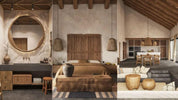
What is “Wabi Sabi”?
, by heartcraft , 3 min reading time

, by heartcraft , 3 min reading time
Wabi-sabi style is closely related to Zen culture, emphasizing the sense of the passing of life and the imperfections of everyday life, and profoundly embodying the Zen culture's ideology of “nothing is hidden in nothing”.
Wabi Sabi is a decorating style favored by the modern design world, which is derived from the ancient Japanese aesthetic concept of “Wabi Sabi”. In the word “Wabi Sabi,” the word ‘wabi’ represents the beauty of simplicity and quietness, and the word “silence” refers to the luster of time. The wabi-sabi style emphasizes acceptance of the imperfections and impermanence of nature, and appreciation of the beauty of the traces and vicissitudes left by the years.

This article contains the following key explanations
What is Wabi-sabi style?
Wabi-sabi (侘(chà)寂) (Wabi-sabi ), originally meaning simplicity, is a unique aesthetic concept that originated in Japan. Its core idea lies in appreciating nature, accepting imperfection, and respecting the natural decay and aging process of things.

In the world of wabi-sabi, beauty does not lie in exuberance and perfection, but in those moments of rusticity, nature and simplicity.

It eschews excessive adornment and flourishes in favor of finding profound serenity in simplicity and pursuing inner peace and depth.

Origin and Background of Wabi-sabi
Historical Background : The history of the Wabi-sabi style as an integral part of Japanese aesthetic consciousness can be traced back to the Southern Song Dynasty. At that time, the monk Eisai brought Zen Buddhism from China to Japan, which profoundly influenced Japanese culture, and under the penetration of Zen Buddhism, the Japanese gradually refined the aesthetic concept of wabi-sabi.

Zen influence: Wabi-sabi style is closely related to Zen culture, emphasizing the sense of the passing of life and the imperfections of everyday life, and profoundly embodying the Zen culture's ideology of “nothing is hidden in nothing”.

Wabi-sabi style and characteristics
Simplicity: Wabi-sabi style pursues minimalism without excessive decoration. From the basic decoration to the soft furnishings, the whole house space does not put extra furnishings, do not do extra ceiling and carving background decoration, do not use colorful decorative paintings, do not do extra soft furnishings collocation.

Ancient and transparent: this style pursues the original rustic texture, focusing on highlighting the real texture of interior elements, such as rusting, the feeling of dead wood, as well as the use of furniture made of natural materials, such as wood, stone, or cotton and linen, to create a rough and true sense of aesthetics.

Color Harmony : The color scheme of wabi-sabi style is simple and harmonious, often using earth tones, such as light gray, beige, and earthy yellow, to give a sense of stability and solidity. At the same time, some natural elements such as wood and stone colors are also added in moderation, filling the overall space with a natural atmosphere.

Wabi-sabi design concept
The beauty of imperfection: Wabi-sabi style adopts a philosophy of beauty in imperfection, which allows and appreciates the imperfections and flaws of things as a reflection of their authenticity and uniqueness.

Environmentally friendly and sustainable : In the choice of decoration materials, Wabi-silent Wind tends to use environmentally friendly and renewable materials to minimize pollution of the environment, which is in line with the environmental trend of modern society.

Space layout and planning
Reasonable division: Wabi-sabi style focuses on the layout and planning of space, and through reasonable space division and flow design, the space is both practical and full of aesthetics.

Design Tips : In order to improve the utilization of space and comfort, you can make use of some design tips, such as setting up partitions and creating multi-functional areas.

Wabi-sabi style is an understated, minimalist, simple and close-to-nature decorating style, which reflects people's profound pursuit and understanding of the aesthetics of life. In modern society, wabi-sabi style not only provides people with a comfortable and peaceful living environment, but also allows people to feel the beauty and true meaning of life in it.
